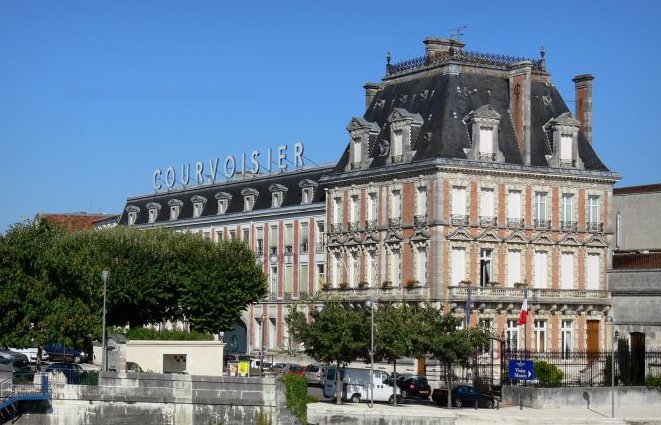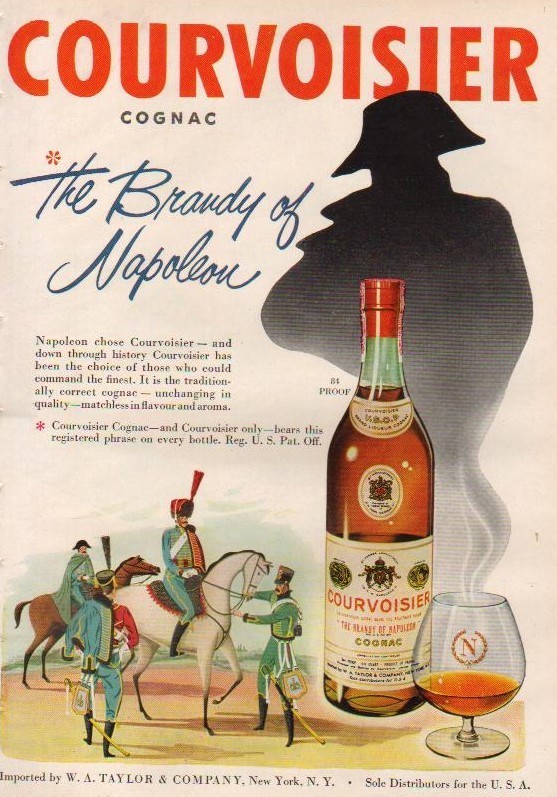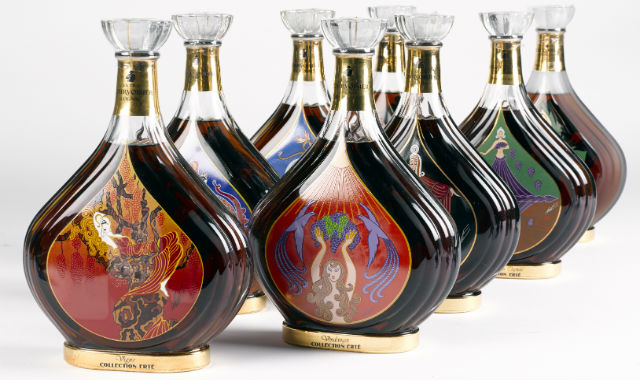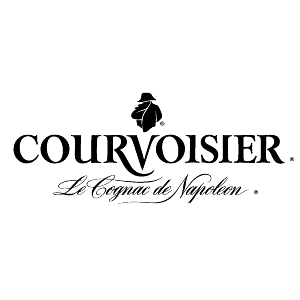Courvoisier, cognac firm in Jarnac

- 1809 Emmanuel Courvoisier (=Emile Courvoisier) and Louis Gallois, mayor of Bercy (a suburb of Parijs), open a liquor store in Bercy.
- 1811 It is said that Emmanuel Courvoisier was already selling cognac to Napoléon in 1811 in Bercy.
- 1828 Jules Gallois (son of Louis) begins a subsidiary in eau-de-vie and cognac in Jarnac, together with Léopold Caboche.
- 1828 and 1835 are both dates that sometimes are mentioned as date of establishment. On the website of Paul Ronne (cognac-paul.com) one can find an invitation for the 100th aaniversary of the company in 1928.
- In the forties of the 19th century the name Courvoisier comes in the picture for real, when Félix Courvoisier, son of Emmanuel, becomes the manager for Jules Gallois’ business in Bercy.
- At the same time he associates with Caboche to continue the firm of Jules-Gallois in Jarnac. The name of the firm: Félix Courvoisier-Caboche.
- 1840 The Chateau in Jarnac is being built.
- 1849 Louis Gallois dies.
- 1851 Léopold Caboche dies. Félix Courvoisier is sole owner.
- 1855 (sometimes the year 1851 is being mentioned as the date for this association) Félix Courvoisier associates with his nephew, (the son of his sister Emilie Courvoisier), Jules Curlier. The firm is called F. Courvoisier & Cie.
- 1862 Renovation of the company and a new associate: Emile Curlier. For a period of time the name of the firm has been ” F. Courvoisier et Curlier Frères, maison fondée en 1828 “
- 1866 Félix Courvoisier dies without descendants.
- 1866-1870 the firm continues as Societé Veuve Courvoisier & Curlier Frères.
- 1870 Marie-Joséphine Courvoisier dies, the name Courvoisier disappears and becomes Curlier. The Curlier brothers run the company untill 1909.
- 1909 The company is unexpectedly handed over to the Simon family in London for unknown reasons. Guy and Georges Simon are form French origin. One had been the British agent for Courvoisier for trade on that side of the Canal.
- The Simon family reintroduce the name Courvoisier for their products. They have their headquarters in London.
- It is also the Simon’s that came up with the slogan ‘The Brandy of Napoléon’ and the famous shadow (l’ombre de Napoleon).
 Although it must be said that Meukow had already used the phrase ‘Cognac Grande Champagne, marque Napoléon’, but this never caught on very well.
Although it must be said that Meukow had already used the phrase ‘Cognac Grande Champagne, marque Napoléon’, but this never caught on very well. - 1940-1945 proceedings during the war: the Simon’s were forced to leave France and asked for the help of Hubert and Braastad. During these years George Hubert and Christian Braastad managed Courvoisier. The company is renamed Hubert et Cie.
- 1945 Courvoisier is handed back to the Simon brothers and of course they again name their company and their products Courvoiser.
- 1964 Courvoisier is sold to Hiram-Walker (Courvoisier owned by Hiram-Walker).
- 1974 Hiram-Walker buys the Salignac company and accomodates the brand at Courvoisier.
- 1986 Hiram-Walker is sold to Allied-Lyons (Courvoisier owned by Allied-Lyons).
- 1994 Domecq buys Allied-Lyons and becomes Allied-Domecq (Courvoisier owned by Allied-Domecq).
- 2005 Pernod-Ricard and Fortune Brands take over Allied-Domecq. Fortune Brands acquires Courvoisier (Courvoisier owned by Fortune Brands).
- 2011 Fortune Brands split up in Fortune Brands Home & Security and Beam Inc. The spirits go to Beam (Courvoisier owned by Beam).
- 2014 Beam is taken over by (Courvoisier owned by Suntory).
Courvoisier never owned any vineyards. They do own two distilleries. They have over 1200 wine-growers under contract and around 300 distilleries in the four best districts: grande and petite champagne, borderies and fins bois. Courvoisier instructs every distillery how the wines are to be distilled.
Guy and Georges Simon came up with the logo of Napoléon. Especially the silhouette contributed enormously to their brand recognition.
During the war the Germans confiscated the company. During these years George Hubert and Christian Braastad were general manager and the firm went by the name Hubert & Cie.
Maître-de-Chai is Patrice Pinet.
The oldest bottle in their ‘Paradis’, the cellar were they keep the oldest cognacs, dates back to 1789, as you can read in the Conal Gregory book on cognac. I found this elsewere in a newspaper article. This is remarkable since they started trading cognac in 1811 at the earliest. But of course it is not impossible they have bought an old stock sometime.
They do add caramel in their VS and VSOP to maintain a constant colour. Boisé is not being used. Sometimes a little cane-sugar sirop is used.
The distillation is usually carried out on the lees, but not always. It depends on the quality of the wines of each year. Fins bois wines however are usually not distilled on the lees.
The first part of the secondes (see under distillation) is added to the next batch of the brouillis; and the last part of the secondes to the next batch of wine to be distilled.
The young eau-de-vie is being put in new casks for a period of 6 to 24 months. After that it goes in old casks. Tronçais wood is being used because it releases less tannin. The casks have medium toasting.
After three months the alcohol-percentage is reduced to 60-65%. After a year the eau-de-vie that is destined for the VS-quality is further reduced to 55%. For the other qualities this is done only after 5-7 year. For this operation petit-eau is used.
The range of Courvoisier are blends unless otherwise stated: C (fins bois), VS, VSOP, VSOP Exclusive, Napoléon Fine Champagne, XO, Initiale Extra, Succession J.S. (grande champagne), L’Essence de Courvoisier, Connoiseur Collection 12 year old, Collection 21 year old, VS Travel Retail Exclusive (fins bois), VSOP Travel Retail Exclusive, XO Travel Retail Exclusive.
The Erté series may not remain unmentioned. Originally they were seven, all painted in Art Déco style by Romain de Tirtoff, a painter of Russian origin who called himself Erté. Each bottle contains a different blend of very old grande champagne cognac, the oldest being from 1892. After Erté died, an eighth bottle was designed in honour of the artist. Each bottle is manually made. Eighteen different colours are being used. The bottle has to be baked in the oven four times and finally the bottle is being hand-panted with 24-karat gold. Each design relates to a different phase in the cognac making process: ‘Vigne’, ‘Vendanges’, ‘Distillation’, ‘Vieillissement’, ‘Degustation’, ‘L’esprit du cognac’, ‘La part des anges’.
After Erté died, an eighth bottle was designed in honour of the artist. Each bottle is manually made. Eighteen different colours are being used. The bottle has to be baked in the oven four times and finally the bottle is being hand-panted with 24-karat gold. Each design relates to a different phase in the cognac making process: ‘Vigne’, ‘Vendanges’, ‘Distillation’, ‘Vieillissement’, ‘Degustation’, ‘L’esprit du cognac’, ‘La part des anges’.
Other brands in possession of Courvoisier or that have been used in the past:
- des Carmes
- Carnac
- Carvalho
- Comte Louis de Naives
- Curlier
- Garde Imperial
- Grandier
- Lafontaine
- Royal Symbol
- Loubert Frères
- Salignac
- Symbole Royale
- Wildmann, Frederick

http://courvoisier.com/
Addresse: 2 place du Château, 16200 Jarnac. Telephone: 0545 355555 (visitors welcome from tuesday till saturday. During summertime open every day. Several tours on offer.)

Hi.First of all i have to say that your Website and your work and effort are fantastic !!
Do you know where to find Paul Ronnes old website?I cant find it where it used to be.If you find it would you please let me know?Thanks.
By the way,i am Norwegian living in England